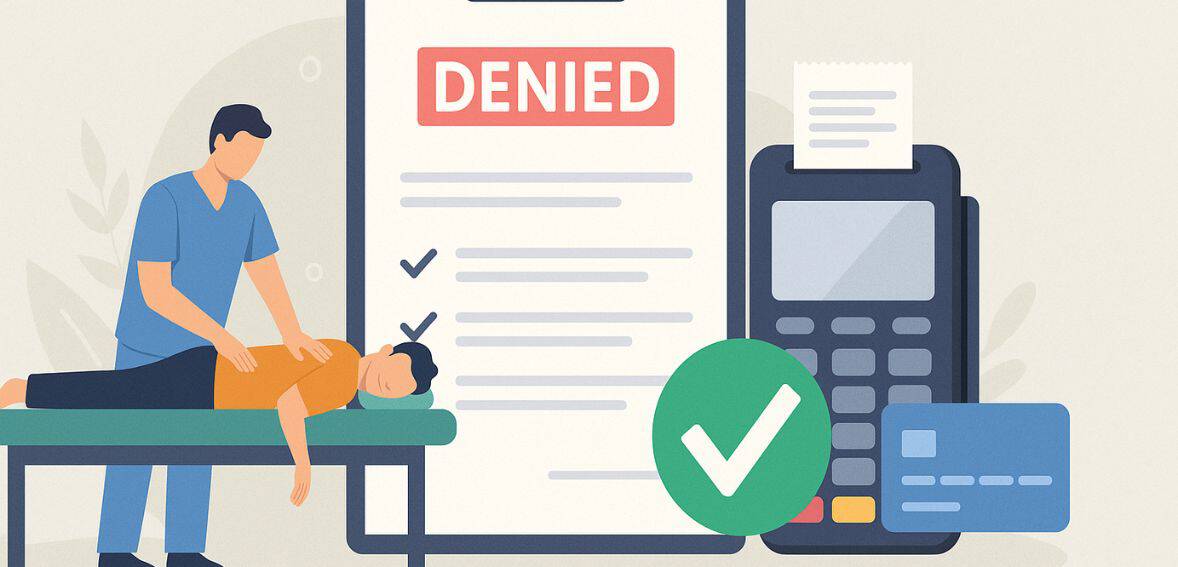
By ElsieCJenkins May 28, 2025
Payment denials It takes more than just providing wellness consultations and spinal adjustments to run a chiropractic practice. Effective financial management is also necessary, particularly with regard to electronic payments and insurance reimbursements. Dealing with payment denials is one of the most annoying problems chiropractors encounter.
In addition to delaying income, these refusals also worsen patient relations, add to administrative workloads, and have an impact on the practice’s financial stability. A number of problems, such as improper coding, a lack of supporting documentation, or payer-specific regulations, can result in payment denials.
But every denial is a waste of time and money, regardless of the reason. Proactively addressing this issue is essential for chiropractors. This manual explores the root causes of chiropractic practice payment denials and offers practical solutions to prevent them ensuring smoother billing cycles, faster payments, and better practice management.
Understanding the Root Causes of Payment Denials
Before fixing the problem, it’s essential to understand what’s causing it. Common reasons for payment denials in chiropractic practices include:
- Coding Errors: Improper or outdated use of CPT, HCPCS, or ICD-10 codes can trigger immediate rejections.
- Insufficient Documentation: Claims lacking clinical justification or required notes are likely to be denied.
- Eligibility Issues: Submitting claims for patients with expired or inactive insurance plans.
- Authorization Lapses: Failing to get pre-authorizations for specific treatments.
- Duplicate Claims: Submitting the same claim multiple times can cause a denial even if one was valid.
- Timely Filing Violations: Claims submitted past the insurer’s deadline.
Understanding these causes helps you design preventive strategies, thereby reducing denials and improving payment reliability.
Boost Documentation Procedures
The cornerstone of any successful claim is documentation. Your notes must clearly comply with coding standards, demonstrate medical necessity, and support the treatment given in order to be reimbursed. Chiropractors should:
- Consistently use SOAP (Subjective, Objective, Assessment, Plan) notes.
- Record patient responses, treatment plans, initial and follow-up evaluations, and assessments.
- Accurately record time-based treatments.
- Document the objectives and results of the treatment.
- Errors can be greatly decreased by using HER systems tailored to chiropractic care or by investing in staff training on appropriate documentation standards.
Actively Check for Patient Insurance Eligibility

Don’t wait until the claim is rejected to find out that the service wasn’t covered or that the patient’s insurance was inactive. Here’s what you should do:
- Prior to the patient visit, use insurance verification tools or portals.
- Verify pre-authorization requirements, co-pays, deductibles, and coverage.
- Record the outcomes of the verification process for every patient interaction.
This procedure can be made more efficient and consistent with the use of automated systems.
Improve the Accuracy of Coding

One of the main causes of denials in chiropractic settings is coding errors. Here’s how to deal with it:
- Keep abreast of the most recent HCPCS, ICD-10, and CPT codes.
- Recognize the distinctions between codes for therapeutic procedures, modalities, evaluation, and manipulation.
- Make use of diagnosis codes that attest to medical necessity.
- Establish a second-level review procedure in which claims are verified by a coder or billing expert.
- Make use of resources like payer-specific coding updates and the ACA’s coding guidelines.
Make Careful Use of Pre-Authorization Protocols
Prior authorization is frequently needed for some services, particularly comprehensive treatment plans or novel modalities. If this is not obtained, denial may occur immediately. Make a list of the services that typically need pre-authorization.
Assign employees the task of obtaining and recording these approvals. Keep track of authorization numbers and make sure to include them when submitting claims. Payer portals can also be used to check the status of authorization in real time.
Implement a Claim Scrubbing Procedure
Prior to submission, claim scrubbing tools examine claim data and identify any possible coding, formatting, or documentation errors. These systems:
- Find any discrepancies between the procedure and diagnosis codes.
- Emphasize any patient or provider information that is missing.
- Cut down on rejections brought on by technical mistakes.
Chiropractic offices that use claim scrubbing tools see much faster reimbursements and a significant decrease in denials.
Train Your Team Constantly
It is necessary to keep billing teams, front desk employees, and even providers informed about changing insurance regulations, documentation standards, and coding conventions. Set up training sessions every three months.
Make use of chiropractic associations’ webinars, online courses, or workshops. Review common denial reasons with your team on a regular basis. In addition to preventing denials, a well-trained staff expedites the correction and appeals process when they do occur.
Appeal Rejected Claims promptly and thoroughly
Sometimes, despite all the precautions, denials will occur. How fast and efficiently you react is what counts.
- Use EOBs (Explanation of Benefits) to determine the reason for the denial.
- Write appeal letters and include the necessary paperwork.
- Keep track of appeal deadlines and conduct thorough follow-up.
One rejection does not equate to a final decision. After a compelling appeal, many chiropractic claims are accepted.
Enhance Practice Management and EHR Software

A large portion of the verification, documentation, and coding process can be automated by investing in HER and billing systems designed specifically for chiropractors. Select systems that combine patient records, scheduling, and billing.
Make sure there are pre-made chiropractic templates in the software. To find reoccurring problems, use reporting tools. Real-time alerts regarding missing data are another feature of contemporary HER systems that aid in identifying denials prior to submission.Real-time alerts regarding missing data are another feature of modern systems that aid in identifying denials before submission. Practices should also be mindful of secure payment standards, which can impact secure payment handling.
Recognize the Payer Policies
Every payer, including Medicare and private insurance, has its own set of regulations. Ignoring these may result in automatic rejections. Keep a collection of payer policy guidelines on hand. Understand the differences between out-of-network and in-network claims. Regularly check for updates or modifications to the policy. Real-time updates and educational materials can be obtained by signing up for a payer’s provider portal.
Monitor Denial Trends and Metrics
What you don’t measure, you can’t fix. Billing reports and denial trends should be routinely examined by practices. Monitor the acceptance rates of first-pass claims. Keep an eye on the most typical denial reasons. Make workflow or policy changes using data. To make this process easier, a lot of practice management systems come with integrated analytics tools.
Billing reports and denial trends should be routinely examined by practices. Monitor the acceptance rates of first-pass claims and watch for patterns in rejections. Using a practice management platform with integrated analytics tools can help identify recurring issues and inform decisions for workflow improvements.
Create Effective Patient Communication
Misinformation or a lack of clarity at the patient level can occasionally lead to denials. Increase openness by:
- Supplying thorough cost analyses prior to treatment.
- Describing the deductibles, co-pays, and insurance benefits.
- Providing financial guidance for expensive procedures.
- Patients who are aware of their obligations are less likely to be denied care because of unpaid balances or miscommunications.
Include Financial Checks Prior to Treatment
Make sure patients are aware of their financial obligations before starting any lengthy treatment plan. Cost estimates are based on insurance verification. Talk about your options for payment, such as third-party financing or installment plans. Obtain agreements on financial responsibility signed. By taking this step, your revenue is protected and the likelihood of retroactive denials is decreased.
Use Expert Billing Services When Necessary

Hiring a chiropractic billing specialist for outsourcing can be a wise choice if handling billing internally is too difficult. Select services that are knowledgeable about payer behavior and codes unique to chiropractors.
Make sure they offer appeal and denial tracking services. Examine their client testimonials and success rates. While outsourcing can lessen workload and improve claim accuracy, it does not remove accountability.
Strengthening Clinical Documentation and Coding Compliance
Improved Utilization of Standardized Coding Practices and SOAP Notes Incomplete or inconsistent documentation is a major factor in chiropractic practices’ payment denials. Improving the quality and organization of SOAP (Subjective, Objective, Assessment, Plan) notes should be a higher priority for chiropractors. The clinical basis for patient care and billing is provided by these notes.
The degree to which treatment choices match recorded patient conditions is being closely examined by insurers. As a result, each service’s medical necessity should be amply supported in entries. Furthermore, claim rejections can be significantly decreased by implementing standardized coding procedures, such as correctly using CPT and ICD-10 codes with matching modifiers. Mismatched diagnosis and procedure codes or excessive use of general codes, such as 98940, without supporting documentation are examples of common mistakes.
Additionally, employees should receive training on payer-specific coding guidelines, particularly for services like spinal adjustments, therapeutic exercises, and modalities. By ensuring that each billing claim is backed by accurate, detailed, and timely records, chiropractic practices can build a defensible case for reimbursement. Investing in electronic health record (EHR) systems that auto-prompt required fields or flag inconsistencies before submission can be a game-changer for improving accuracy and compliance.
Conclusion
It takes more than just filing clean claims to stop payment denials in a chiropractic office; it takes developing a thorough procedure that incorporates precise coding, solid documentation, transparent patient communication, and smart technology use. Payment denials in chiropractic practice—reflects a fundamental problem that can cripple even the most experienced practitioners if left unchecked.
You can drastically reduce denials, delays, and maintain a more robust revenue stream by proactively addressing common causes, training your staff, and utilizing technology. Keep in mind that every denial is a warning sign, not just a missed payment. Converting those red flags into opportunities for improvement guarantees more efficient operations, satisfied patients, and a successful practice.